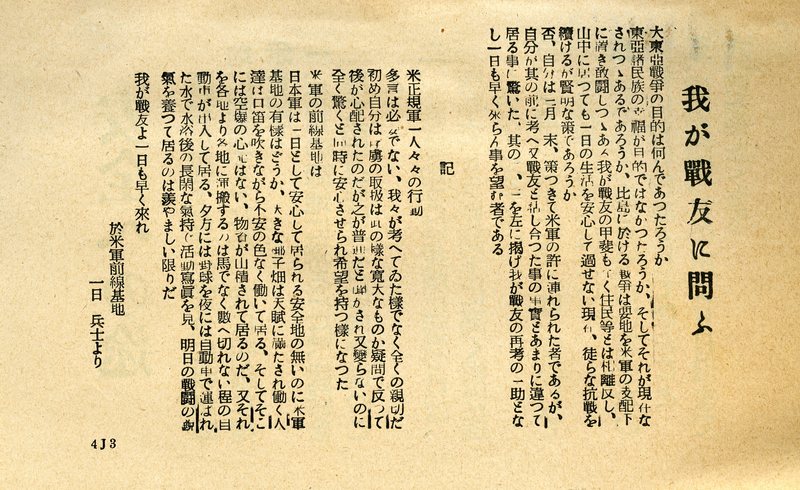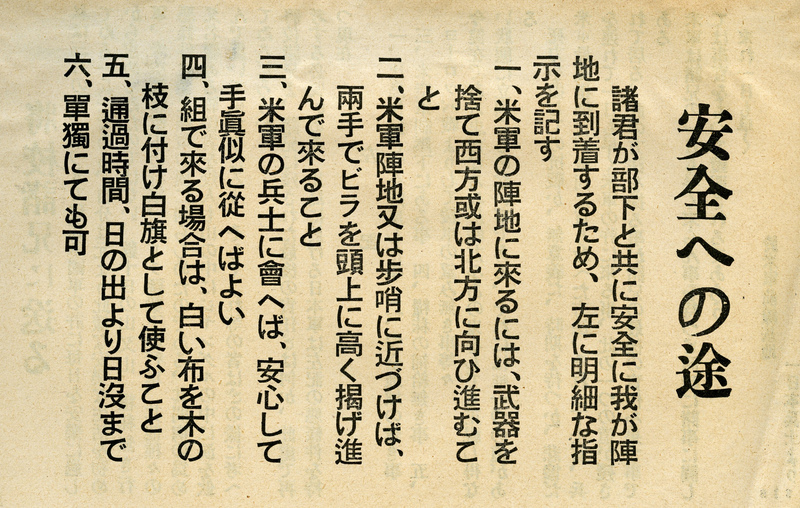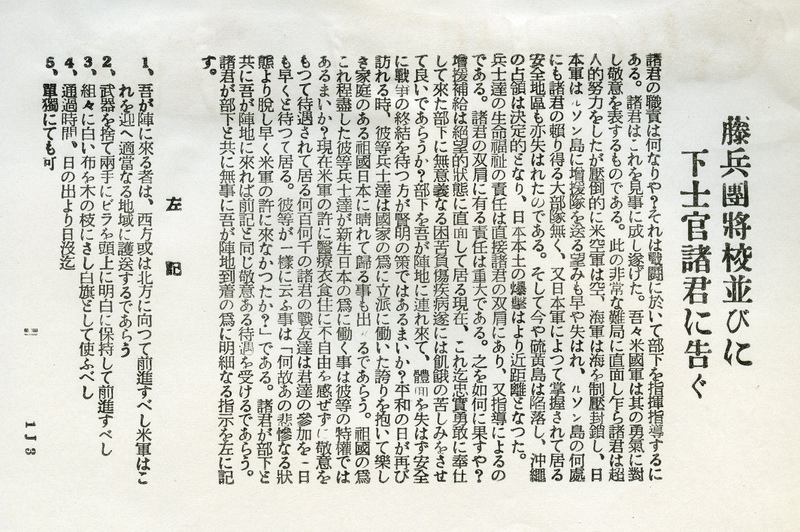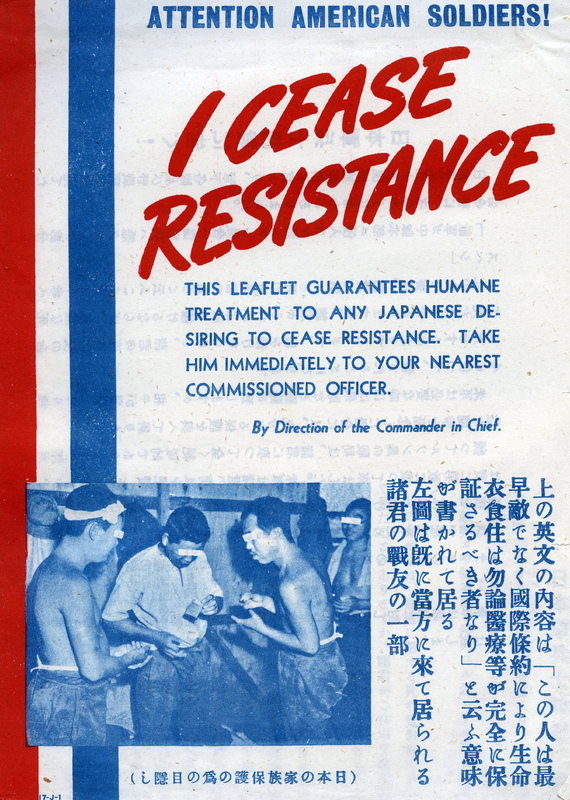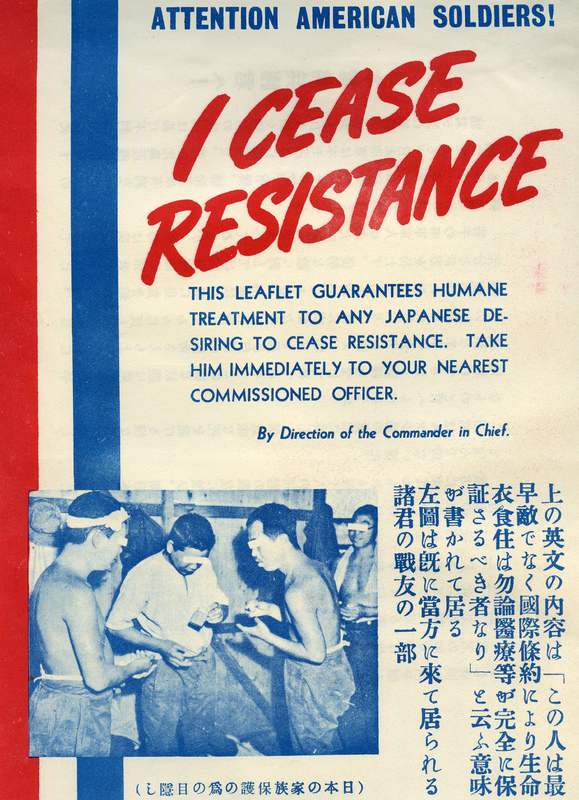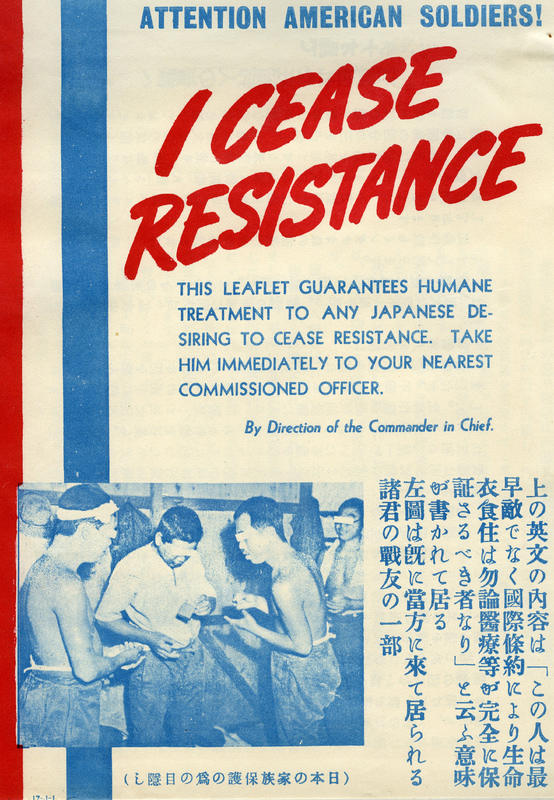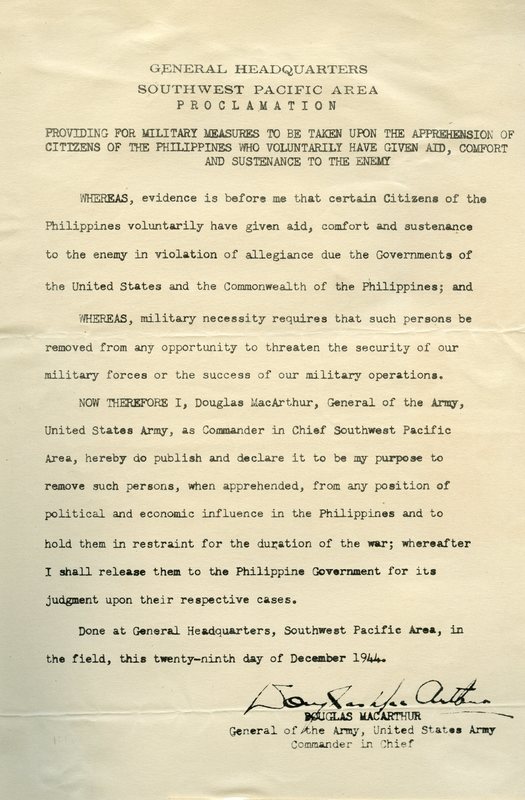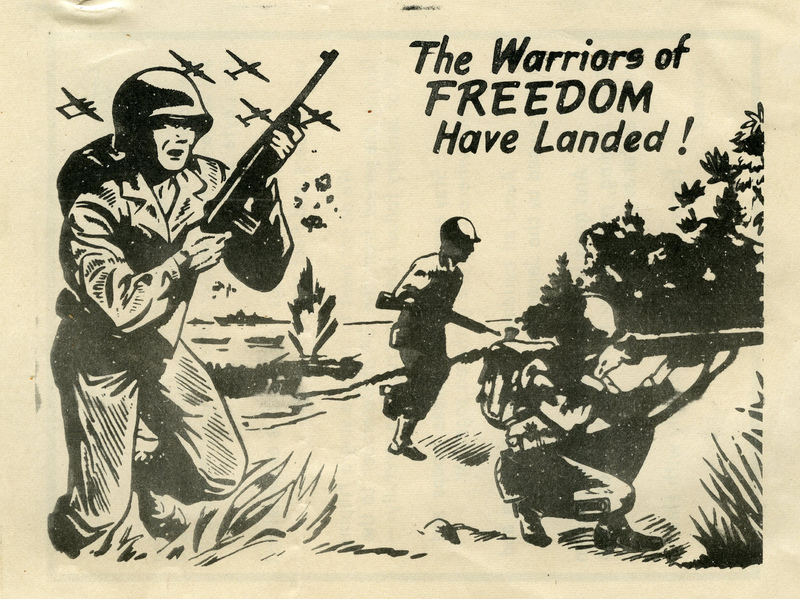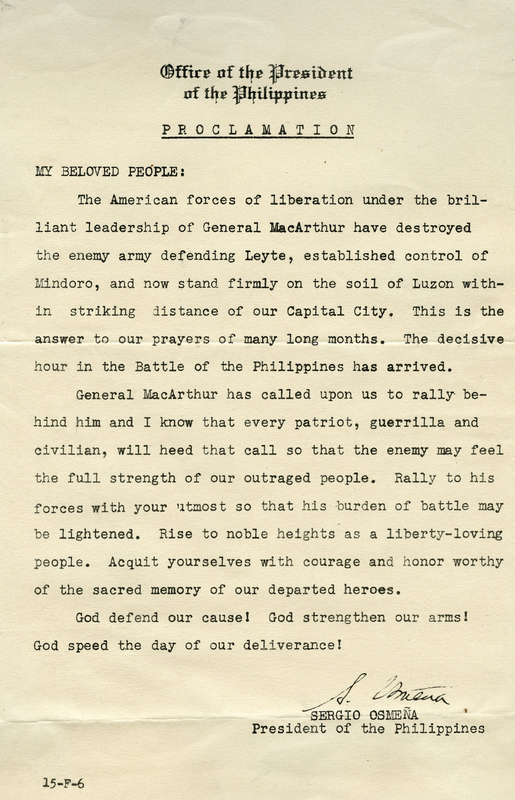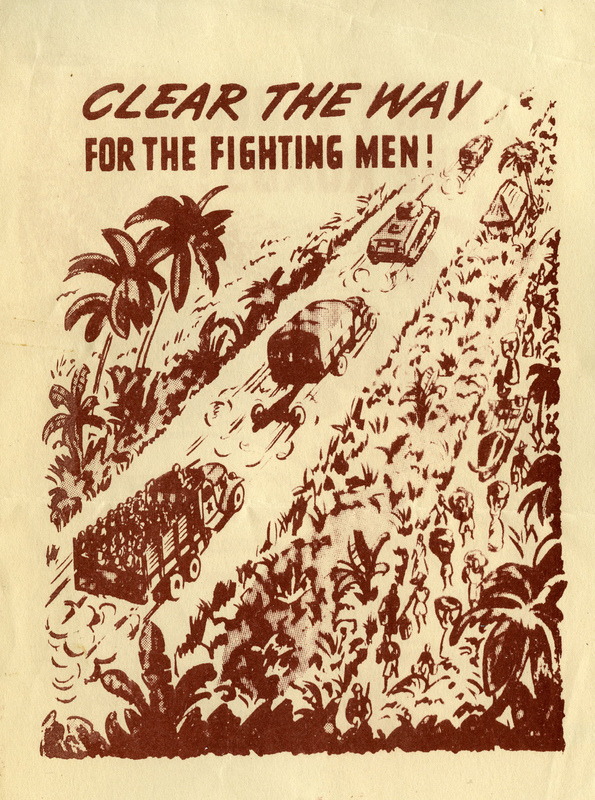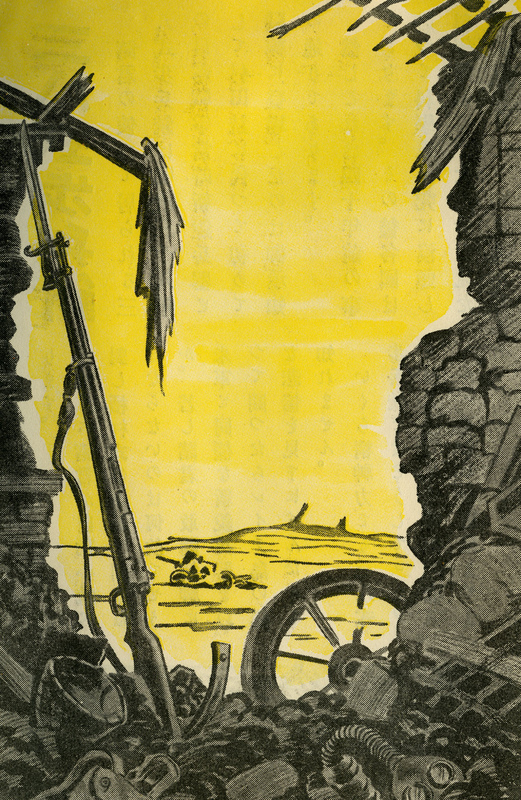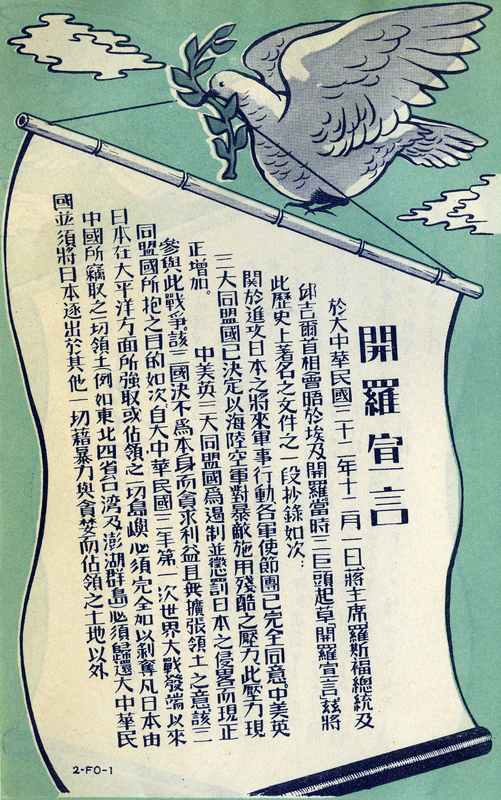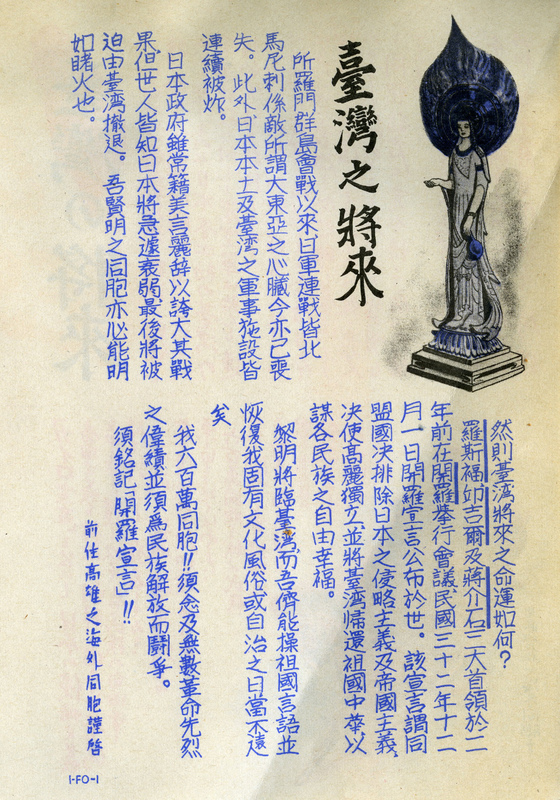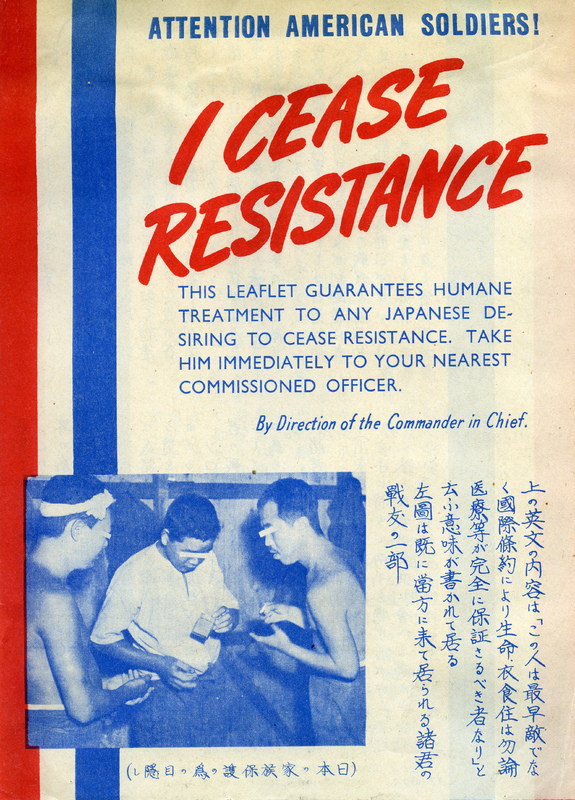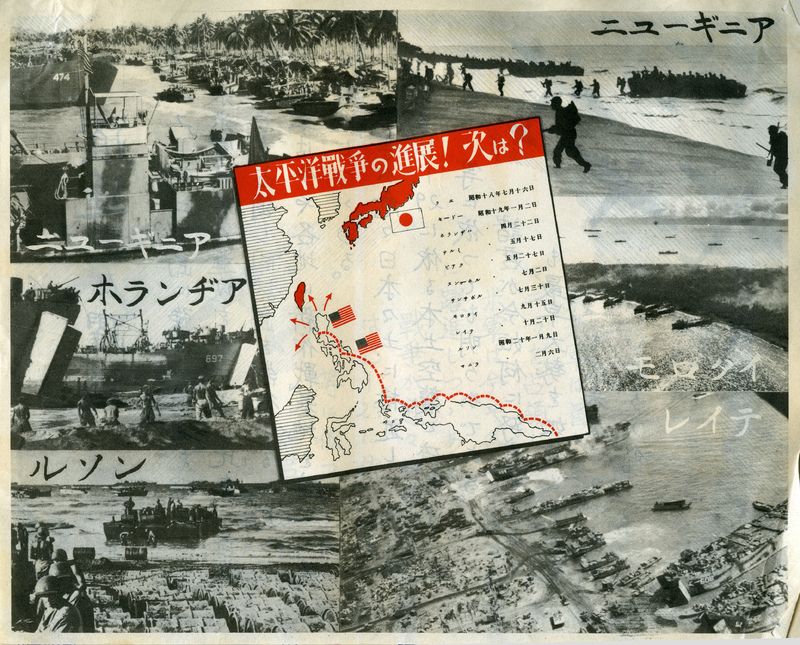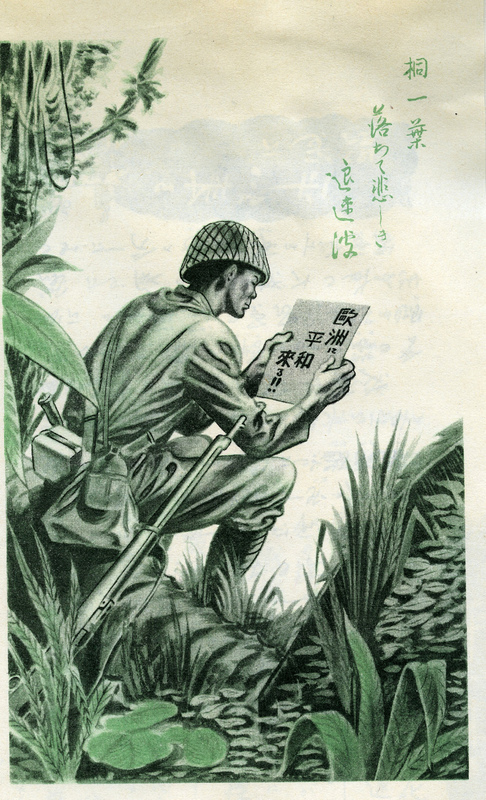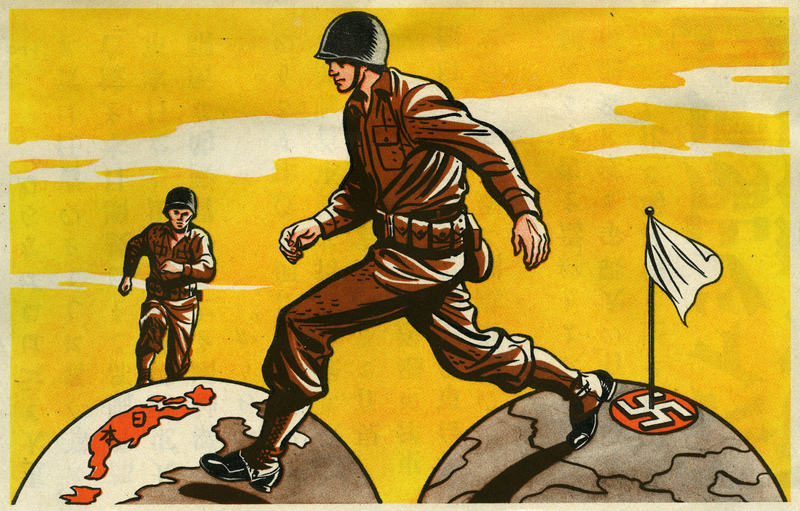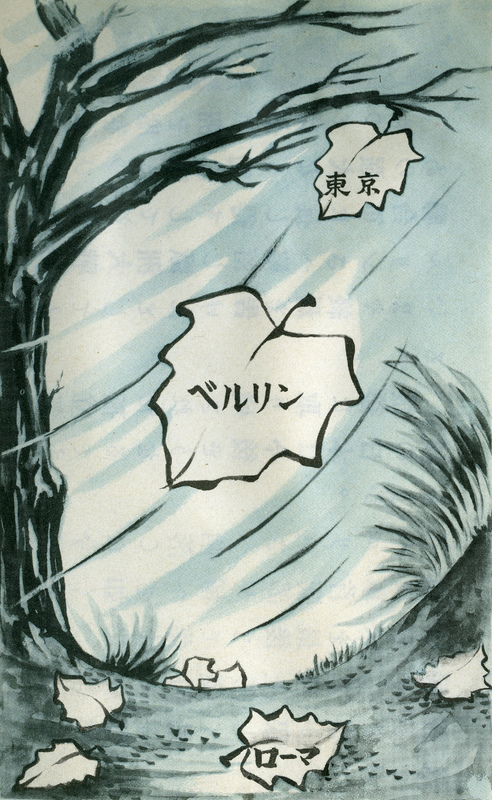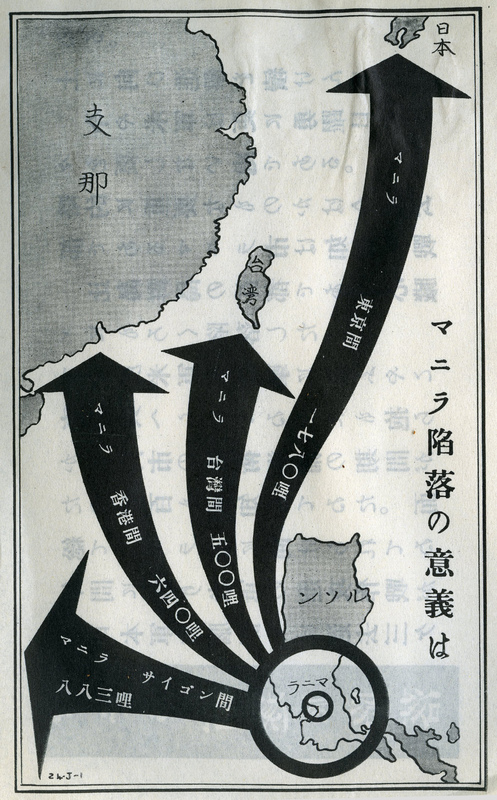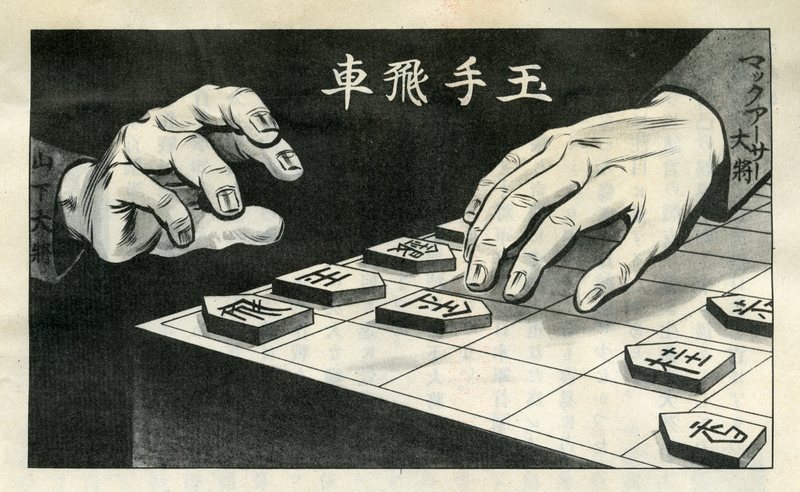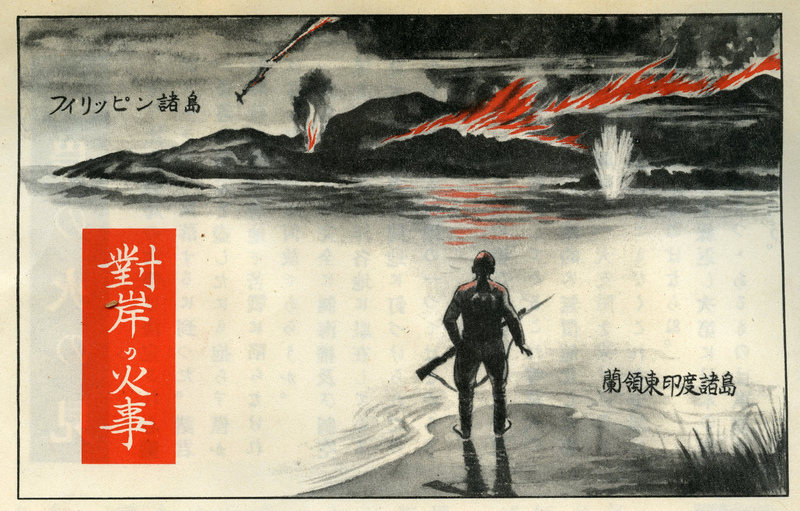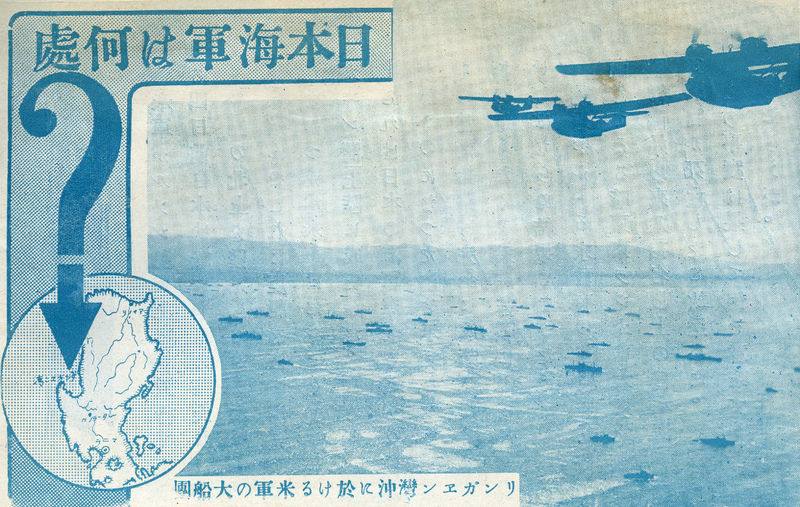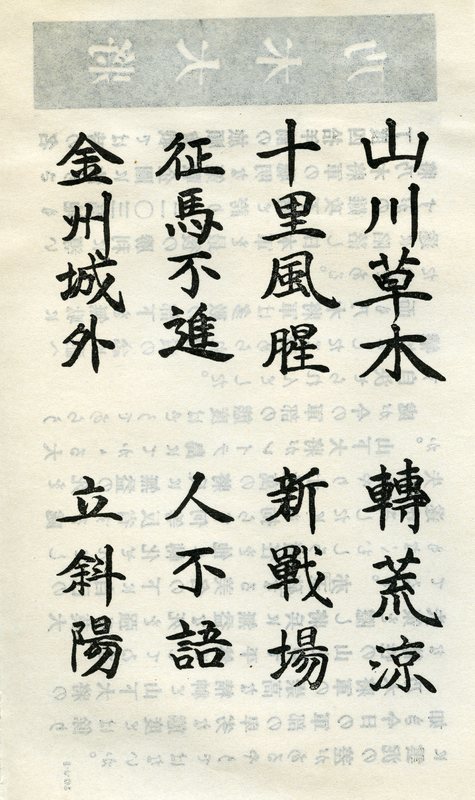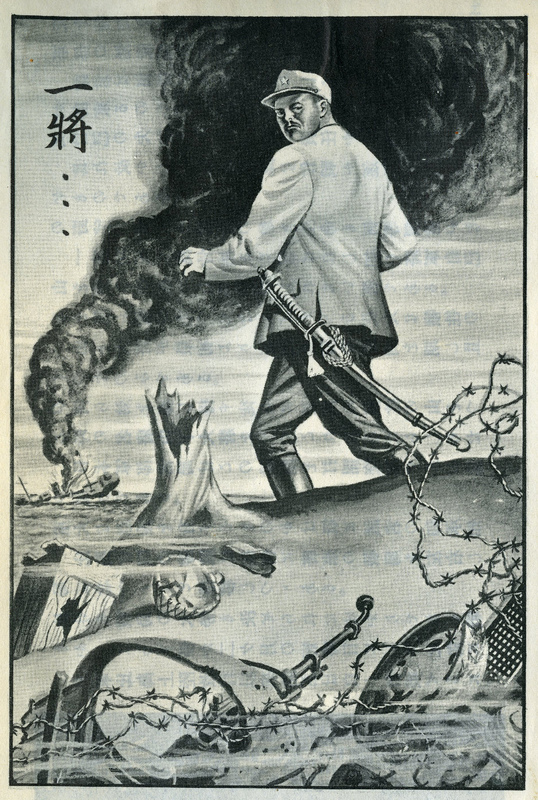Pacific University Archives DPLA
- Title
- Pacific University Archives DPLA
- Description
- An artificial set created to facilitate harvesting of metadata for dp.la.
Items
-
'The Way to Safety, No. 4' propaganda leafletA propaganda leaflet issued by the Allied Forces during World War II after the return of General Douglas MacArthur to the Philippine Islands in 1944. The leaflets were probably airdropped to the Japanese troops, soon after General MacArthur landed in October, 1944. It features a message from a Japanese prisoner of war addressed to his fellow Japanese troops. The text describes the humane treatment that he is receiving and urges his comrades to surrender as well. The back of the leaflet give instructions to Japanese troops on how to surrender to Americans. The intent of this leaflet is to induce the surrender of Japanese troops by demonstrating the humane treatment troops will recieve from the Allied Forces. It is numbered '4J3'. The leaflet is accompanied by an official description and translation of the text into English. This is one item from a scrapbook of propaganda leaflets and related materials that was compiled by the Psychological Warfare Branch of the Allied Forces in the Southwest Pacific Area during World War II. The scrapbook belonged to Colonel Karl F. Baldwin of the United States Army, who helped establish the propaganda program. It contains approximately 200 pieces of propaganda, mostly in Japanese, that were intended for distribution in the Philippines, Japan, and other nearby areas.
-
'The Way to Safety, No. 3' propaganda leafletA propaganda leaflet issued by the Allied Forces during World War II after the return of General Douglas MacArthur to the Philippine Islands in 1944. It was probably airdropped to Japanese troops on the Philippine Islands soon after General MacArthur landed in October, 1944. The leaflet is a message from a Japanese officer that surrendered to the Allied Forces. It instructs his fellow officers to surrender to the Americans, as it is the only option for them. The leaflet gives the instructions for surrendering on the back side. It was intended to induce the surrender of Japanese troops by demoralizing them. It is numbered '3J3'. The leaflet is accompanied by an official description and translation of the text into English. This is one item from a scrapbook of propaganda leaflets and related materials that was compiled by the Psychological Warfare Branch of the Allied Forces in the Southwest Pacific Area during World War II. The scrapbook belonged to Colonel Karl F. Baldwin of the United States Army, who helped establish the propaganda program. It contains approximately 200 pieces of propaganda, mostly in Japanese, that were intended for distribution in the Philippines, Japan, and other nearby areas.
-
'Officers and NCOs of the Fuji Heidan' propaganda leafletA propaganda leaflet issued by the Allied Forces during World War II after the battle for Iwo Jima in 1945. It was probably airdropped to Japanese officers and NCOs on the Philippine Islands soon after the battle of Iwo Jima ended in March, 1945. The leaflet addresses the responsibility the officers and NCOs have with regards to the livelihood of their troops. It gives instructions on how to surrender to the Allied Forces and promises humane treatment of prisoners of war. The leaflets were intended to induce the surrender of Japanese troops. It is numbered '1-J-3'. The leaflet is accompanied by an official description and translation of the text into English. This is one item from a scrapbook of propaganda leaflets and related materials that was compiled by the Psychological Warfare Branch of the Allied Forces in the Southwest Pacific Area during World War II. The scrapbook belonged to Colonel Karl F. Baldwin of the United States Army, who helped establish the propaganda program. It contains approximately 200 pieces of propaganda, mostly in Japanese, that were intended for distribution in the Philippines, Japan, and other nearby areas..
-
'Order to Kill J. Sick and Wounded' propaganda leafletA propaganda leaflet issued by the Allied Forces during World War II after the return of General Douglas MacArthur to the Philippine Islands in 1944. It was probably airdropped to Japanese troops on the Philippine Islands in the Luzon area, soon after General MacArthur landed in October, 1944. One side features the words 'I Cease Resistance' with instructions for Japanese troops to present the leaflet to any American soldier for guaranteed humane treatment. This side of the leaflet is numbered '17-J-1'. The back side of the leaflet contains a message for Japanese troops in Luzon. The text states that the Japanese Army has received ordered to dispose of any sick or wounded troops. This side of the leaflet is numbered '7-J-11'.It was intended to induce the surrender of Japanese troops. The leaflet is accompanied by an official description and translation of the text into English. This is one item from a scrapbook of propaganda leaflets and related materials that was compiled by the Psychological Warfare Branch of the Allied Forces in the Southwest Pacific Area during World War II. The scrapbook belonged to Colonel Karl F. Baldwin of the United States Army, who helped establish the propaganda program. It contains approximately 200 pieces of propaganda, mostly in Japanese, that were intended for distribution in the Philippines, Japan, and other nearby areas.
-
'Army Protects Navy' propaganda leafletA propaganda leaflet issued by the Allied Forces during World War II after the return of General Douglas MacArthur to the Philippine Islands in 1944. It was probably airdropped to Japanese troops on the Philippine Islands soon after General MacArthur landed in October, 1944. One side features the words 'I Cease Resistance' with instructions for Japanese troops to present the leaflet to any American soldier for guaranteed humane treatment. The back of the leaflet addresses the Japanese army in the Luzon mountains that have been abandoned. It explains that no one is going to rescue them and their only way out is to surrender. This leaflet was intended to induce the surrender of Japanese troops by demoralizing them. It is numbered '1-J-11'. The leaflet is accompanied by an official description and translation of the text into English. This is one item from a scrapbook of propaganda leaflets and related materials that was compiled by the Psychological Warfare Branch of the Allied Forces in the Southwest Pacific Area during World War II. The scrapbook belonged to Colonel Karl F. Baldwin of the United States Army, who helped establish the propaganda program. It contains approximately 200 pieces of propaganda, mostly in Japanese, that were intended for distribution in the Philippines, Japan, and other nearby areas.
-
'To Inducted Japanese on Mindanao' propaganda leafletA propaganda leaflet issued by the Allied Forces during World War II after the return of General Douglas MacArthur to the Philippine Islands in 1944. It was probably airdropped to Japanese troops on the Philippine Islands soon after General MacArthur landed in October, 1944. One side features the words 'I Cease Resistance' with instructions for Japanese troops to present the leaflet to any American soldier for guaranteed humane treatment. The other side of the leaflet implores Japanese residents living in Mindanao to hand over their arms and avoid joining the fight against the Allied Forces. It stresses the folly of the Japanese Militarists and assured victory of the Americans. The leaflet is numbered '3-J-10'. It is accompanied by an official description and translation of the text into English. This is one item from a scrapbook of propaganda leaflets and related materials that was compiled by the Psychological Warfare Branch of the Allied Forces in the Southwest Pacific Area during World War II. The scrapbook belonged to Colonel Karl F. Baldwin of the United States Army, who helped establish the propaganda program. It contains approximately 200 pieces of propaganda, mostly in Japanese, that were intended for distribution in the Philippines, Japan, and other nearby areas.
-
General Douglas MacArthur Proclamation leafletA leaflet issued by the Allied Forces during World War II after the return of General Douglas MacArthur to the Philippine Islands in 1944. The leaflets were probably airdropped to the citizens of the Philippine Islands soon after General MacArthur landed in October, 1944. It was a proclamation by General MacArthur of the removal of any persons of influence in political or economic positions if they collaborate with the enemy. This is one item from a scrapbook of propaganda leaflets and related materials that was compiled by the Psychological Warfare Branch of the Allied Forces in the Southwest Pacific Area during World War II. The scrapbook belonged to Colonel Karl F. Baldwin of the United States Army, who helped establish the propaganda program. It contains approximately 200 pieces of propaganda, mostly in Japanese, that were intended for distribution in the Philippines, Japan, and other nearby areas.
-
'The Warriors of Freedom Have Landed' flierA flier issued by the Allied Forces during World War II after the return of General Douglas MacArthur to the Philippine Islands in 1944. The flier was probably airdropped to the citizens of the Philippine Islands soon after General MacArthur landed in October, 1944. It features instructions to stay away from certain areas between the dates December 15th and January 8th. The instructions state to leave the beaches and head inland as soon as Allied Forces appear on the beaches. The flier is numbered '7F6'. This is one item from a scrapbook of propaganda leaflets and related materials that was compiled by the Psychological Warfare Branch of the Allied Forces in the Southwest Pacific Area during World War II. The scrapbook belonged to Colonel Karl F. Baldwin of the United States Army, who helped establish the propaganda program. It contains approximately 200 pieces of propaganda, mostly in Japanese, that were intended for distribution in the Philippines, Japan, and other nearby areas.
-
President Sergio Osmena Proclamation flierA flier issued by the Allied Forces during World War II after the return of General Douglas MacArthur and President Osmena to the Philippine Islands in 1944. The flier was probably airdropped to the citizens of the Philippine Islands soon after General MacArthur and President Osmena landed in October, 1944. It is a proclamation written by President Sergio Osmena urging the Filipino citizens to rally their support for General Douglas MacArthur and the American troops. The flier is numbered '15-F-6'. This is one item from a scrapbook of propaganda leaflets and related materials that was compiled by the Psychological Warfare Branch of the Allied Forces in the Southwest Pacific Area during World War II. The scrapbook belonged to Colonel Karl F. Baldwin of the United States Army, who helped establish the propaganda program. It contains approximately 200 pieces of propaganda, mostly in Japanese, that were intended for distribution in the Philippines, Japan, and other nearby areas.
-
'Clear the Way for the Fighting Men' flierA flier issued by the Allied Forces during World War II after the return of General Douglas MacArthur and President Osmena to the Philippine Islands. The flier was probably airdropped to the citizens of the Philippine Islands soon after General MacArthur and President Osmena landed in October, 1944. It contained instructions for Filipinos to keep the roads clear for the American troops. This is one item from a scrapbook of propaganda leaflets and related materials that was compiled by the Psychological Warfare Branch of the Allied Forces in the Southwest Pacific Area during World War II. The scrapbook belonged to Colonel Karl F. Baldwin of the United States Army, who helped establish the propaganda program. It contains approximately 200 pieces of propaganda, mostly in Japanese, that were intended for distribution in the Philippines, Japan, and other nearby areas.
-
'Type 38 Rifle' propaganda leafletA propaganda leaflet issued by the Allied Forces during World War II after the return of General Douglas MacArthur to the Philippine Islands in 1944. The leaflets were probably airdropped to the Japanese troops on the Philippine Islands soon after General MacArthur landed in October, 1944. One side features an illustration of destruction on a battlefield, with a Type 38 rifle amongst the carnage. The other side features text explaining that the Type 38 rifle was useful 40 years ago, but is now far inferior to the Allied Forces weapons. The leaflets were intended to create a sense of helplessness by causing the Japanese to lose confidence in their weapons and induce the surrender of Japanese troops. It is numbered '33-J-1'. The leaflet is accompanied by an official description and translation of the text into English. This is one item from a scrapbook of propaganda leaflets and related materials that was compiled by the Psychological Warfare Branch of the Allied Forces in the Southwest Pacific Area during World War II. The scrapbook belonged to Colonel Karl F. Baldwin of the United States Army, who helped establish the propaganda program. It contains approximately 200 pieces of propaganda, mostly in Japanese, that were intended for distribution in the Philippines, Japan, and other nearby areas.
-
'Cairo Declaration' flierA paper flier issued by the Allied Forces for the people of the Island of Formosa during World War II after the return of General Douglas MacArthur to the Philippine Islands. The flier was probably air dropped soon after General MacArthur landed in October, 1944. The text is written in Chinese on one side and Japanese on the other side. The flier explains the Cairo Declaration and the status afforded to Formosa following the end of Japanese occupation. It was intended to inform the people of Formosa of the Allied Forces post-war aims with regards to the Island of Formosa. It is numbered '2-FO-1'. The flier is accompanied by an official description and translation of the text into English. This is one item from a scrapbook of propaganda leaflets and related materials that was compiled by the Psychological Warfare Branch of the Allied Forces in the Southwest Pacific Area during World War II. The scrapbook belonged to Colonel Karl F. Baldwin of the United States Army, who helped establish the propaganda program. It contains approximately 200 pieces of propaganda, mostly in Japanese, that were intended for distribution in the Philippines, Japan, and other nearby areas.
-
'Future of Formosa' flierA paper flier issued by the Allied Forces for the people of Formosa during World War II after the battle for Manila 1945. The flier was probably airdropped on Formosa soon after the battle for Manila ended in March, 1945. It is written in Chinese on one side and Japanese on the other. It features an image of the Chinese war god on one side and a Chinese religious figure on the other. The flier describes the Allied Forces victories in the Solomon Islands and Manila, and the likelyhood of the Japanese troops retreat from Formosa. It explains the status that Formosa will have once the Japanese have left the island of Formosa, according to the Cairo Declaration. The intent of this leaflet was to give the people of Formosa hope of liberation. The flier is numbered '1-FO-1'. It is accompanied by an official description and translation of the text into English. This is one item from a scrapbook of propaganda leaflets and related materials that was compiled by the Psychological Warfare Branch of the Allied Forces in the Southwest Pacific Area during World War II. The scrapbook belonged to Colonel Karl F. Baldwin of the United States Army, who helped establish the propaganda program. It contains approximately 200 pieces of propaganda, mostly in Japanese, that were intended for distribution in the Philippines, Japan, and other nearby areas.
-
'I Cease Resistance' propaganda leafletA propaganda leaflet issued by the Allied Forces during World War II after the return of General Douglas MacArthur to the Philippine Islands in 1944. The leaflets were probably airdropped to Japanese troops on the Philippine Islands soon after General MacArthur landed in October, 1944. One side features a Japanese soldier that has surrendered being treated well by the Americans. The other side explains that the International Law is followed by the Americans, and any Japanese soldier that surrenders will be treated well. The leaflets were meant to induce the surrender of Japanese troops by demonstrating the treatment they will receive after surrendering. It is numbered '17-(A)-J-1'. The leaflet is accompanied by an official description and translation of the text into English. This is one item from a scrapbook of propaganda leaflets and related materials that was compiled by the Psychological Warfare Branch of the Allied Forces in the Southwest Pacific Area during World War II. The scrapbook belonged to Colonel Karl F. Baldwin of the United States Army, who helped establish the propaganda program. It contains approximately 200 pieces of propaganda, mostly in Japanese, that were intended for distribution in the Philippines, Japan, and other nearby areas.
-
'One Stride After Another' propaganda leafletA propaganda leaflet issued by the Allied Forces during World War II soon after the successful battle of Iwo Jima in March, 1945. The leaflets were probably airdropped to Japanese troops on the Philippine Islands. One side features photographs of Allied Forces victories with a list of their advances. The other side explains the Allied Forces advances are bringing them closer to the Japanese homeland. The intent of the leaflet was to demoralize Japanese troops by pointing out their weaknesses, with the hope of inducing their surrender. It is numbered '32-J-1'. The leaflet is accompanied by an official description and translation of the text into English. This is one item from a scrapbook of propaganda leaflets and related materials that was compiled by the Psychological Warfare Branch of the Allied Forces in the Southwest Pacific Area during World War II. The scrapbook belonged to Colonel Karl F. Baldwin of the United States Army, who helped establish the propaganda program. It contains approximately 200 pieces of propaganda, mostly in Japanese, that were intended for distribution in the Philippines, Japan, and other nearby areas.
-
'Peace in Europe' propaganda leafletA propaganda leaflet issued by the Allied Forces during World War II after the end of the war in Europe in 1945. The leaflets were probably airdropped to Japanese troops on the Philippine Islands soon after the war ended in Europe in May, 1945. One side features an illustration of a Japanese soldier reading a paper with the headline 'The European War Has Ended'. The other side features text describing the peace in Europe and the end of hunger, carnage and battle. It states that men will soon be reunited with their families. The intent of the leaflet was to demoralize Japanese troops by pointing out their weaknesses, with the hope of inducing their surrender. It is numbered '28-J-1'. The leaflet is accompanied by an official description and translation of the text into English. This is one item from a scrapbook of propaganda leaflets and related materials that was compiled by the Psychological Warfare Branch of the Allied Forces in the Southwest Pacific Area during World War II. The scrapbook belonged to Colonel Karl F. Baldwin of the United States Army, who helped establish the propaganda program. It contains approximately 200 pieces of propaganda, mostly in Japanese, that were intended for distribution in the Philippines, Japan, and other nearby areas.
-
'Fall of Germany' propaganda leafletA propaganda leaflet issued by the Allied Forces during World War II after the fall of Berlin in 1945. The leaflets were probably airdropped to Japanese troops, soon after the fall of Berlin in May, 1945. One side features an illustration of Allied troops leaving Germany and stepping towards Japan, symbolizing the Allied Forces leaving defeated Germany and heading for Japan. The other side features text stating that Germany has fallen and now the full focus of the Allied Forces would shift to Japan. The intent of the leaflet was to demoralize Japanese troops by pointing out their weaknesses, with the hope of inducing their surrender. It is numbered '27-J-1'. The leaflet is accompanied by an official description and translation of the text into English. This is one item from a scrapbook of propaganda leaflets and related materials that was compiled by the Psychological Warfare Branch of the Allied Forces in the Southwest Pacific Area during World War II. The scrapbook belonged to Colonel Karl F. Baldwin of the United States Army, who helped establish the propaganda program. It contains approximately 200 pieces of propaganda, mostly in Japanese, that were intended for distribution in the Philippines, Japan, and other nearby areas.
-
'Fall of Berlin' propaganda leafletA propaganda leaflet issued by the Allied Forces during World War II after the fall of Berlin in 1945. The leaflets were probably airdropped to Japanese troops, soon after the fall of Berlin in May, 1945. One side features an illustration of a leaf falling off of a Paulownia tree with 'Berlin' written on it. A leaf with 'Rome' written on it lays on the ground, while a leaf with 'Tokyo' written on it remains on the tree. The other side features a message about the fall of Berlin and the once great German army. It puts blame on the Japanese military leaders for their destruction of land and their sacrificing of Japanese lives. The intent of the leaflet was to demoralize Japanese troops by pointing out their weaknesses, with the hope of inducing their surrender.It is numbered '26-J-1'. The leaflet is accompanied by an official description and translation of the text into English. This is one item from a scrapbook of propaganda leaflets and related materials that was compiled by the Psychological Warfare Branch of the Allied Forces in the Southwest Pacific Area during World War II. The scrapbook belonged to Colonel Karl F. Baldwin of the United States Army, who helped establish the propaganda program. It contains approximately 200 pieces of propaganda, mostly in Japanese, that were intended for distribution in the Philippines, Japan, and other nearby areas.
-
'Manilla has Fallen' propaganda leafletA propaganda leaflet issued by the Allied Forces during World War II, soon after their successful invasion of Manila. The leaflets were airdropped to Japanese troops on the Philippine Islands soon after the Allied Forces took control of Manila in March, 1945. The front features an image of Manila on a map, with arrows leading from Manila to areas close by. It was intended to show the strategic location of Manila to other Japanese strongholds. The back announces that the Allied Forces have successfully taken over control of Manila. While explaining that the American troops are in high morale and are ready to strike again. The intent of the leaflet was to demoralize Japanese troops by pointing out their weaknesses, with the hope of inducing their surrender. It is numbered '24-J-1'. The leaflet is accompanied by an official description and translation of the text into English. This is one item from a scrapbook of propaganda leaflets and related materials that was compiled by the Psychological Warfare Branch of the Allied Forces in the Southwest Pacific Area during World War II. The scrapbook belonged to Colonel Karl F. Baldwin of the United States Army, who helped establish the propaganda program. It contains approximately 200 pieces of propaganda, mostly in Japanese, that were intended for distribution in the Philippines, Japan, and other nearby areas.
-
'Two Strategies' propaganda leafletA propaganda leaflet issued by the Allied Forces during World War II after their successful invasion of the Lingayen Gulf in 1945. The leaflets were probably airdropped to Japanese troops on the Philippine Islands soon after the Allied Forces victory in the Lingayen Gulf in January, 1945. One side features an image of two men playing chess, with the names MacArthur and Yamashita on their sleeves. The image contains the word 'Checkmate' at the top. The other side describes General Douglas MacArthur's dominance over General Yamashita. The intent of the leaflet was to demoralize Japanese troops by pointing out their weaknesses, with the hope of inducing their surrender. It is numbered '23J1'. The leaflet is accompanied by an official description and translation of the text into English. This is one item from a scrapbook of propaganda leaflets and related materials that was compiled by the Psychological Warfare Branch of the Allied Forces in the Southwest Pacific Area during World War II. The scrapbook belonged to Colonel Karl F. Baldwin of the United States Army, who helped establish the propaganda program. It contains approximately 200 pieces of propaganda, mostly in Japanese, that were intended for distribution in the Philippines, Japan, and other nearby areas.
-
'Watching Fires on the Further Shore' propaganda leafletA propaganda leaflet issued by the Allied Forces during World War II after the successful invasion of the Ling.ayen Gulf in 1945. The leaflets were probably airdropped to Japanese troops on the Philippine Islands soon after the Allied Forces victory in the Lingayen Gulf in January, 1945. The front contains an image of a lone Japanese soldier watching the battle in the Lingayen Gulf from afar. The back contains a message to Japanese troops. The intent of the leaflet was to demoralize Japanese troops by pointing out their weaknesses, with the hope of inducing their surrender. It is numbered '22J1'. The leaflet is accompanied by an official description and translation of the text into English. This is one item from a scrapbook of propaganda leaflets and related materials that was compiled by the Psychological Warfare Branch of the Allied Forces in the Southwest Pacific Area during World War II. The scrapbook belonged to Colonel Karl F. Baldwin of the United States Army, who helped establish the propaganda program. It contains approximately 200 pieces of propaganda, mostly in Japanese, that were intended for distribution in the Philippines, Japan, and other nearby areas.
-
'Japanese Fleet' propaganda leafletA propaganda leaflet issued by the Allied Forces during World War II after the successful invasion of the Lingayen Gulf in 1944. The leaflets were probably airdropped to Japanese troops on the Philippine Islands soon after the Allied Forces victory in the Lingayen Gulf in January, 1945. One side features an image of the American invasion convoy in the Lingayen Gulf, with the words 'Where is the Japanese Fleet?'. The other side has statements about the battle and the Japanese losses, with particular emphasis on the loss of Japanese supply routes. The intent of the leaflet was to demoralize Japanese troops by pointing out their weaknesses, with the hope of inducing their surrender. It is numbered '21J1'. The leaflet is accompanied by an official description and translation of the text into English. This is one item from a scrapbook of propaganda leaflets and related materials that was compiled by the Psychological Warfare Branch of the Allied Forces in the Southwest Pacific Area during World War II. The scrapbook belonged to Colonel Karl F. Baldwin of the United States Army, who helped establish the propaganda program. It contains approximately 200 pieces of propaganda, mostly in Japanese, that were intended for distribution in the Philippines, Japan, and other nearby areas.
-
'General Nogi' propaganda leafletA propaganda leaflet issued by the Allied Forces during World War II after the return of General Douglas MacArthur to the Philippine Islands in 1944. The leaflets were probably airdropped to Japanese troops on the Philippine Islands soon after General MacArthur landed in October, 1944. One side features a poem written by Japanese General, Yamashita. The other side questions the Japanese military leaders, their responsibility for Japanese troops deaths and the lack of responsibility taken by General Yamashita. This leaflet was meant to drive a wedge between Japanese troops and their commanders with the hope of inducing the surrender of Japanese troops. It is numbered '20J1'. The leaflet is accompanied by an official description and translation of the text into English. This is one item from a scrapbook of propaganda leaflets and related materials that was compiled by the Psychological Warfare Branch of the Allied Forces in the Southwest Pacific Area during World War II. The scrapbook belonged to Colonel Karl F. Baldwin of the United States Army, who helped establish the propaganda program. It contains approximately 200 pieces of propaganda, mostly in Japanese, that were intended for distribution in the Philippines, Japan, and other nearby areas.
-
'One General' propaganda leafletA propaganda leaflet issued by the Allied Forces during World War II after the return of General Douglas MacArthur to the Philippine Islands in 1944. The leaflets were probably airdropped to Japanese troops on the Philippine Islands soon after General MacArthur landed in October, 1944. One side features an image of Japanese General, Yamashita, walking away from a battlefield in defeat. The back side of the leaflet condemns General Yamashita for sacrificing so many Japanese troops. The leaflet is meant to drive a wedge between the Japanese troops and their military commanders with the hopes of inducing the surrender of Japanese troops. It is numbered '19J1'. It is accompanied by an official description and translation of the text into English. This is one item from a scrapbook of propaganda leaflets and related materials that was compiled by the Psychological Warfare Branch of the Allied Forces in the Southwest Pacific Area during World War II. The scrapbook belonged to Colonel Karl F. Baldwin of the United States Army, who helped establish the propaganda program. It contains approximately 200 pieces of propaganda, mostly in Japanese, that were intended for distribution in the Philippines, Japan, and other nearby areas.

